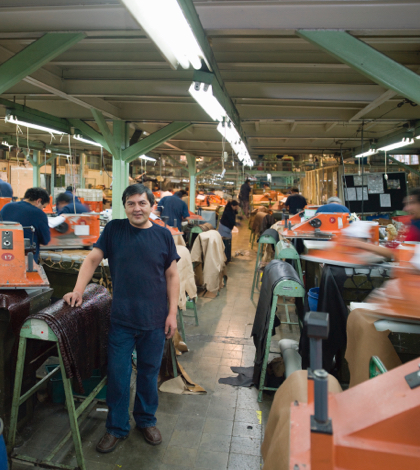The region has gained back some of the manufacturing jobs it lost during the recession, though not in overwhelming numbers. Affordable land might be one reason, but everyone is hoping the trend continues.
Who said manufacturers are avoiding the Inland Empire?
That may be the conventional wisdom, just as it is for the state of California, but some recent numbers say otherwise.
The region best known for warehouse-distribution operations added approximately 3,500 manufacturing jobs from September 2014 through August of 2015, according to the state Employment Development Department.
That’s not a huge number, and it hardly makes up for the manufacturing jobs that were lost during the recession, said Jordan Levine, economist and director of economic research with Beacon Economics in Los Angeles.
Still, that was nearly a four percent increase year-over-year, an above-average gain for the region in any 12-month period.
The average salary of a manufacturing job – defined as anyone who helps produce a durable or non-durable product – in Riverside and San Bernardino counties in 2014 was $53,963, the EDD stated in its most recent manufacturing numbers.
That helps explain why municipalities and their economic development directors desire manufacturing operations above all others, but the reason manufacturing jobs are so coveted goes beyond salaries.
“You get high-skilled people into your market, and you also get more capital investment the more manufacturing you get,” Levine said. “In general, manufacturing jobs are just more attractive than jobs in other sectors.”
For years, the state’s business community has complained that California businesses are burdened with too many regulations, particularly regarding environmental protections, and that those regulations have forced a lot of manufacturers to either leave the state or not come here in the first place.
That may be true in coastal communities like Los Angeles and San Francisco, but it could be that the central markets like the Inland Empire have an advantage, at least for now, in attracting manufacturing jobs.
“I wasn’t surprised when I saw those numbers, but I’m sure there were people in the business community who were,” Levine said. “Maybe the state overall could have performed better, just there are markets in California that have done very well in manufacturing lately, and the Inland Empire is one of them. The numbers are pretty clear on that.”
But the Inland manufacturing numbers are only good, not outstanding, and not too much should be read into them, said Jay Prag, professor of economics and finance at the Drucker School of Management at the Claremont Colleges.
“The United State has been losing manufacturing jobs for three decades, and so has the Inland Empire,” Prag said. “The biggest loss was when General Dynamics shut down in Pomona after the Cold War ended, and we’ve been trying to replace them ever since.
“What’s been happening lately in the Inland Empire isn’t bad, but it’s not a large number, either. We still have a long way to go before we get back all of the manufacturing jobs we lost.”
Prag agrees that the Inland Empire, with its supply of affordable land, has an advantage over other markets when trying to attract manufacturing companies, but he said he also sees a potential obstacle in that area: the region’s massive logistics industry.
The hundreds of warehouse-distribution operations in both counties has added to traffic congestion on all of the region’s major freeways, and that might discourage some manufacturers from locating here.
“Traffic is already bad on the 10, the 210, the 60 and the 91,” Prag said in reference to four of the major freeways that traverse the Inland region. “That could be a problem because manufacturers are looking to move their goods out of the area once they’re made.”
Inland economist John Husing called the additional 3,500 jobs “a good number,” and said his own data shows the region added about 300 more manufacturing jobs during that time.
The Inland Empire began adding manufacturing positions as soon as the recession began to wane: it posted 1,600 manufacturing jobs in 2012, then followed that with 600 more in 2013, a modest number but still in the black, Husing said.
The Inland Empire is following the state trend: California added approximately 32,000 manufacturing jobs between January 2014 and June of this year. That’s a good performance given the fact that California – which accounts for about four percent of the manufacturing jobs in the Unites States – is not friendly to manufacturing.
“We have some of the highest energy costs of any state west of the Mississippi River,” said Husing, who rails constantly about California being hostile to business, especially manufacturing, due to too much regulation and the price of electricity. “Our energy is 156 percent more expensive than Nevada’s, which is doing everything it can to take businesses from us. To add any manufacturing jobs with those numbers is impressive.”
Keeping that trend going could be difficult for more reasons than the price of electricity, said Barbara Sirotnik, co-director of the Institute of Applied Research and Policy Analysis at Cal State San Bernardino, which issues a monthly report on the state of manufacturing in the Inland Empire.
The Inland region remains largely a blue collar market, with many of its residents having a high school education or less, and that’s a negative when trying to attract manufacturing businesses, Sirotnik said.
“Manufacturing jobs are getting more and more high-tech, and that means they require more education and more training,” Sirotnik said. “That could work against us. Right now, I would be happy to see our manufacturers stay here.”
 IE Business Daily Business news for the Inland Empire.
IE Business Daily Business news for the Inland Empire.


